Keywords
|
| recycled aggregate, compressive strength, flexural strength, modulus elasticity |
INTRODUCTION
|
| Concrete is the most favourite material used in construction industry. Because concrete has basic ingredients that are easy to find, namely cement, coarse aggregate, fine aggregate, and water. Moreover, the maintenance of concrete is also easily to conduct, most economical, good in compression, durable and good fire resistance. |
| In terms of making a construction, most of people use new materials as concrete mixture because people do not think yet about the use of recycled materials from building utilized materials (recycled materials from ruin building) as green building, According to Akbari (Akbari et al, 2011), one of the developing country which has used recycled aggregate as concrete mixture is Malaysia. Furthermore, the use of recycled aggregate is not only applied in Malaysia, but also in the developed countries South Africa, Netherland, United Kingdom (UK), Germany, France, Russia, Canada and Japan (Parekh and Modhera, 2002). |
| Based on the background of problem, the researcher will described the following research statement: 1. How are the comparison between Recycled coarse Aggregate (RCA) and natural aggregate NCA? 2. How is the comparison between Recycled Concrete Aggregate with 0%, 35%, 50% and 65% in compressive strength, flexural strength and modulus elasticity? |
LITERATURE REVIEW
|
| The function of aggregate has the influence of the construction quality; therefore the type and quality of aggregate are very important to be concerned. The fine and coarse aggregates generally use 60% to 75% of the concrete volume (70% to 85% by mass) and will influence the concrete’s freshly mixed and hardened properties, mixture proportions, and economy. Moreover, fine aggregate usually consists of natural sand with particles around 4.75mm (0.2 in); then in terms of coarse aggregate it is usually combination of gravels or crushed stone with particles larger than 4.75 mm (0.2 in.) and generally between 9.5 mm and 37.5 mm (3⁄8 in. and 11⁄2 in.) (Gomez, 2003). Then, the natural aggregate consists of gravel and sand can be used after those materials through processing. The process of materials for natural aggregate is only minimal process through the dug or dredged from a pit, river, lake, or seabed (Gomez, 2003). |
| Moreover, the discussion about recycled aggregate usually correlate with recycled coarse aggregate. Coarse recycled concrete aggregate (RCA) is produced by crushing the demolition waste of at least 95% by weight of concrete, and having a total contaminant level typically lower than 1% of the bulk mass. Other materials that may be present in RCA are gravel, crushed stone, hydraulic-cement concrete or a combination thereof deemed suitable for premix concrete production (Anonymous, 2008). |
| Moreover, in terms of RCA use will influence high water absorption of recycled aggregate, of concrete (Fumoto and Yamada, 2006). This is due to the migration of water absorbed by the aggregate to the paste around particles of aggregates, then, the water absorption will influence volume of water and pores in the paste. Recycled fine aggregate has high water absorption because it contain a large quantity of hydrated cement paste from the demolished concrete. Increasing the level of cleanliness of RCA, in terms of the amount of mortar adhering to aggregate particles, has been found to improve the workability, mass per unit volume and compressive strength of the concrete and to reduce the air content (Montgomery and Sturgiss, 1996). |
METHODOLOGY
|
| The research was conducted in laboratory in MUHAMMADIYAH UNIVERSITY SURAKARTA. The variable of this research were as follow: |
| 1. Dependent variable : compressive strength 28 days |
| 2. Independent variable : recycled coarse aggregate |
| The data type of this research includes two types of data, namely: |
| 1. Primary Data, namely the data which is used directly in the research, such as research materials, and equipment to support the research. |
| 2. Secondary Data, namely the data which is used by researcher not directly in the research, but this data is used by researcher as supporting data such as literature review, and journals. |
| The researcher used 4 types of mix concrete which are made from OPC. Each type contains 0%, 35%, 50% and 65% recycled aggregate. Researcher adopted the method of Mix design of Concrete: British stander BS 5328 and BS 8110 for the design of concrete mix.. The materials which were used are local fine aggregate and coarse aggregate with a maximum size of 20 mm for batch 1 and maximum size 10 mm for batch 2. |
 |
 |
RESULT AND ANALYSIS
|
Recycled Aggregate Test and Natural aggregate.
|
| In this study, the recycled aggregate has been used from a crushed concrete cube. The researcher manually crushed the concrete to match the specifications of the gradation of the coarse aggregate. After the washing process to get rid of dust and drying, the researcher tested the recycled aggregate such as coarse aggregate. |
 |
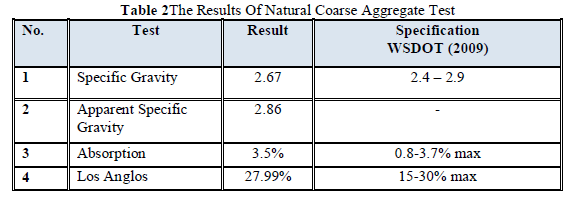 |
| Based on Table 1 and 2.it can be seen that specific gravity was lower than the specification. The lower score of specific gravity than specification because of impure aggregate used in the mixture. The impure condition of recycled aggregate happened because the aggregate was mixed with cement concrete in the previous time. Then, the condition of this recycled aggregate will absorb more water. |
| Water absorption of recycled aggregate can be proven from the higher percentages of water absorption than the specification. In the context of this research, water absorption was 7.5% and this score was higher than the WSDOT (2009) specification in 3.7% maximum. |
| The high absorption of water by recycled aggregate because of the paste on the gravel. Cement paste which was stick to gravel had many pores which will influence the ability of absorption.High levels of water absorption in the recycled aggregate, will greatly affect the mix design activities that will be performed on phase for further research. With high levels of absorption, resulting in the amount of water required at the stage of mixing and mix design will be more than the mix concrete mix design that uses natural aggregates as aggregates. |
| Moreover, in terms of Los Angles test for this research was higher than the specification. This condition happened when the recycled coarse aggregate is used for the manufacture of concrete with no natural aggregate composition. The high level of the break-out is also due to the aggregate of the tested actually been fused with the hardened cement paste, which when inserted into the machine Los Angeles cement paste will be easily eroded, whereas the cement paste is calculated as the weight of the object being tested (5000gram). Thus, from these tests can be seen also that the recycled aggregate is already contains quite a lot of cement paste. |
| Based on the result of properties of Recycled Aggregate and natural coarse aggregate, it can be seen that specific gravity for natural coarse aggregate is higher than Recycled Aggregate, and the value of specific gravity for natural coarse aggregate is 2.64, it means that natural coarse aggregate meet the requirement of specific gravity. Moreover, in terms of Apparent Specific Gravity of Natural Coarse Aggregate is also higher than Recycled Aggregate. It can be seen that the Natural Coarse Aggregate is 2.87 while Recycled Aggregate is 2.79. Then, in terms of absorption, the value for Natural Coarse Aggregate is 3 % and the value of Recycled Aggregate is 7.5%, while the standard for absorption is 3.7%. Furthermore, in finally, the value of Los Angeles for Natural Coarse Aggregate is 27.9%, while the value for Recycled Aggregate is 36.56%. It means that the Los Angeles value for Natural Coarse Aggregate is under the standard which is recommended, namely 30%;max in the other hand the value of Los Angeles for Recycled Aggregate is higher than standard. |
| Based on the research result, it can be seen that the result is in line with the statement of Fumoto and Yamada (2006), although RCA has an economic benefit aspect, it also has weakness in terms of specific gravity. In the context of this research, the result of specific gravity was only 2.29 and lower than the result of Fumoto and Yamada (2006) that the result of research was 2.44-2.46. |
Slump Test
|
| The test was run in accordance with ASTM C143. Based on the result of slump test, it can be seen that the result of slump test were almost similar. When the researcher did not added the Recycled Aggregate in Batch 1 to mixture, the slump value was 10.50 cm, then when the researcher added Recycled Aggregate into 35%, 50% and 65% the value of slump were 9.50 cm. Moreover, in terms of Batch 2, the researcher used the minimum size of Recycled Aggregate with 4,75 and maximum size 10 mm. The result of slump test were 10.1 cm as the highest number of slump, then when researcher added 35% of Recycled Aggregate in the mixture, the slump test value was drop to 8.41. Then, the result of slump test was keep on decreasing when the researcher added more recycled aggregate into mixture. |
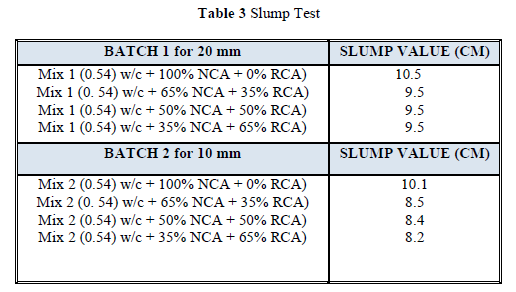 |
| Based on the research result of slump test, it can be known that the add of recycled aggregate to the mixture will influence the value of slump test. The value of slump test is keep on decrease when the researcher added more percentage of Recycled Aggregate. |
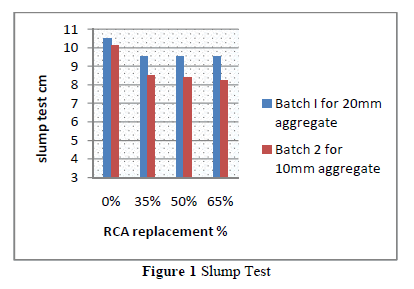 |
| This research was in line with (Zuhud, 2008) that the value of slump test of RCA kept on increasing when the percent of RCA was decrease. Moreover, this result also in line with research result of Ismail and Ramli (2014) that the value ofslump test of RCA depends on percentage of RCA; when the slump test decrease, the percentage of RCA is increase and versa. |
Compressive Strength
|
| Compressive strength is defined as the maximum resistance of a concrete cube to axial loading. Testing of specimens was carried out after curing. Specimen dimensions were measured before testing. Clean and surface dried specimens were placed in the testing machine. The platen was lowered and touched the top surface of the specimen. The load was applied at the gradually and maximum load was the recorded. |
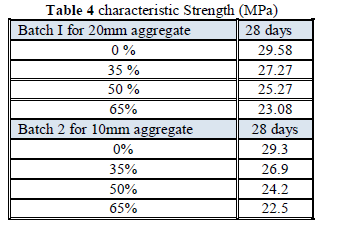 |
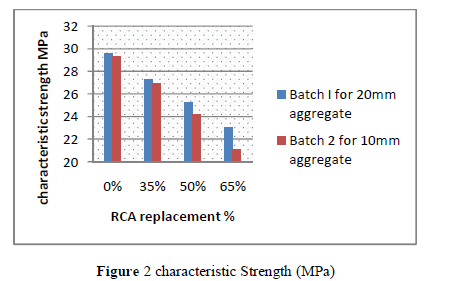 |
| Based on the test results of these experimental, it could be seen that characteristic Strength of recycled aggregate concrete depends on the strength of original concrete, and that it is controlled by a combination of the water cement ratio of the original concrete and water–cement ratio of the recycled aggregate concrete. |
| Based on the result, it can be seen that the result of characteristic Strength of the use of recycled aggregate will not improve the characteristic Strength. The replacement of recycled aggregate on concrete will decrease the characteristic Strength. In the context of Batch 1, the characteristic Strength for 0% was 29.58 MPa, 35% Recycled Aggregate was 27.27 MPa, 50% |
| Recycled Aggregate was 25.27 MPa and 65% Recycled Aggregate was 23.08 MPa. Then, in terms of Batch 2, the characteristic Strength for 0% Recycled Aggregate was 29.3 MPa, 35% was 26.9 MPa, 50% was 24.2 MPa and 65% was 22.5 MPa. |
| This research was in line with (akbari et al (2011)) that the there's no significant change in compressive strength from 0% up to 30 % of coarse Recycled Aggregate but after 30% we can notes that there is significant change in characteristic Strength. |
| Then, based on the research result and the previous research of Limbachiya (2000), and Dhir et al (1986), the existence of recycled aggregate will influence the characteristic Strength. However The more recycled aggregate added will decrease the value of characteristic Strength because recycled aggregate has different characteristic, such as the ability to water Absorption. Recycled aggregate can absorb more water than natural aggregate because recycled aggregate has many pores to absorb the water and it will influence the characteristic Strength. |
Modulus Elasticity
|
| Based on the research result, it can be seen that the increase of Recycled Aggregate will decrease the value of modulus elasticity. When the researcher did not added Recycled Aggregate to mixture in batch 1the modulus elasticity was 27665 N/mm2; while the researcher added Recycled Aggregate to 35%, the value of modulus elasticity was 26871 N/mm2, then when the researcher added Recycled Aggregate to 50%, the value was decreased to 25628 N/mm2 and the value was decreased into 24498 N/mm2 when the researcher added 65% Recycled Aggregate ,Then, in terms of Batch 2, the modulus elasticity with 0% was 26402 N/mm2; while the researcher added Recycled Aggregate to 35%, the value of modulus elasticity was 24567 N/mm2, then when the researcher added Recycled Aggregate to 50%, the value was decreased to 23656 N/mm2 and the value was decreased into 22545 N/mm2 when the researcher added 65% Recycled Aggregate. |
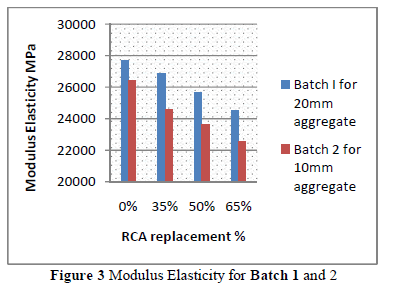 |
| This research was in line with Hansen (2003) that had conducted a series of experiments to determine the effect of grade of original concrete on modulus of elasticity. They obtained three types of aggregate namely, H, M, and L by crushing laboratory made conventional concrete of high strength, medium strength and lower strength respectively. Recycled aggregate concretes of high strength, medium strength and low strength, having same mix proportions as the three original concretes, but with all nine possible combinations of aggregates were prepared and tested for modulus of elasticity. The test results of these set of experiments reveal that, both dynamic and static modulus of elasticity are from 14% to 28% lower for recycled aggregate concrete than for corresponding conventional concretes. However it is evident that difference in modulus of elasticity would have been much larger if the high strength, concrete had been made with softer aggregate than the natural aggregate which was actually used in the experiment. |
| Moreover, according to Topcu (2005) obtained the complete stress–strain curve of recycled aggregate concrete with the RCA replacement percentages of 0%, 30%, 50%,70% and 100%, and he found that with the increase of Recycled Aggregate amount, the values of the elastic modulus decrease by about 30%. Xiao et al (2002) has noted that the elastic modulus of recycled aggregate concrete is lower than that of the normal concrete. It decreases as the recycled aggregate content increases. |
Flexural Strength
|
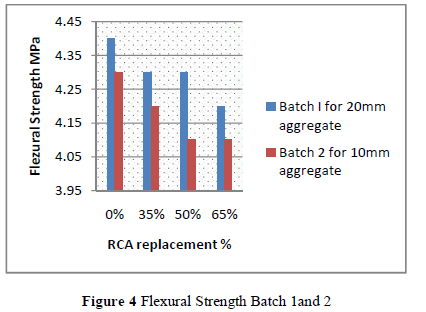 |
| Based on the result of research, it can be seen that the result of flexural strength for Recycled Aggregate in Batch 1. When the researcher used 0% of Recycled Concrete Aggregate the value of flexural strength was 4.4 N/mm.Then, when the researcher added percentage of Recycled Aggregate to 35%, the result of flexural strength were decrease and the result were decrease again when the researcher added Recycled Aggregate into 50%. Moreover, when the researcher added Recycled Aggregate into 65%, the value of flexural strength was decrease again into 4.2 N/mm. |
| In Batch 2, the flexural strength was 4.3 N/mm.2 when the researcher added 0% Recycled Aggregate, then, when the researcher added Recycled Aggregate into 35% the value of flexural strength was decrease to 4.2 N/mm.2. The value of flexural strength was kept on decrease when the researcher added Recycled Aggregate into 50% and 65%. |
| This research result was in line with Ravindrarajah and Tam (2002) at first found no significant difference in flexural strength of conventional concrete and recycled aggregate concrete. However, later they only have reported that flexural strength of recycled aggregate concrete is consistently 10% lower than corresponding conventional concrete. |
| This condition due to the same water cement ratio. In the context of this research, the researcher used same water cement ratio, namely 0.54. moreover, in Batch 2, the flexural strength was lower than Batch 1, this condition due to the add of more recycled aggregate in the mixture and the size of aggregate that was smaller than Batch 1. |
CONCLUSION
|
| 1. The value of specific gravity and apparent specific gravity, of Natural Coarse Aggregate were meet the requirement however the Recycled Aggregate doesn’t meet the requirements and was lower than the Natural Coarse Aggregate. Then the value of absorption and los Angeles of Natural Coarse Aggregate was lower than Recycled Aggregate and meet the requirements |
| 2. The value of Recycled Aggregate with 0% that is normal concrete was the highest score for compressive strength,. Then, when Recycled Aggregate was added to the mixture, the value of compressive strength, were decrease. It can be concluded that the value of compressive strength will be decreased when more Recycled Aggregate was used. |
| 3. The value of Recycled Aggregate with 0% that is normal concrete was the highest score for Modulus Elasticity,. Then, when Recycled Aggregate was added to the mixture, the value of Modulus Elasticity, were decrease. It can be concluded that the value of Modulus Elasticity will be decreased when Recycled Aggregate was used. |
| 4. The value of Recycled Aggregate with 0% was the highest score for Flexural Strength,. Then, when Recycled Aggregate was added to the mixture, the value of Flexural Strength, were decrease. It can be concluded that the value of Flexural Strength will be decreased when Recycled Aggregate added, however there is no significant change in Flexural Strength test. |
| 5. Based on the research result for batch1 20 mm max The decrease in compressive strength with 35% replacement of RCA is 7.87% and with 50% of RCA the decrease is 16% also with 65%of RCA the decrease 23.3%, however in batch2 with 10 mm max the decrease with 35% of RCA is 8.1% then with 50%of RCA the decrease is 17.4 and 65% of RCA the decrease is 23.2. |
| 6. The percentage from Recycled coarse Aggregate that can be used in concrete is maximum 35% replacement of Recycled coarse Aggregate. |
References
|
- Anonymous. 2008. Use of Recycled Aggregate in Construction. Cement Concrete and Aggregate Australia.
- Akbari, Y.V., Arora, N.K., Vakil, M.D. 2011. Effect on Recycled Aggregate on Concrete Properties. International Journal of Earth Sciences andEngineering ISSN 0974-5904, Volume 04, No 06 SPL, October 2011, pp. 924-928
- Fraaij, A.L., Pieterson, H.S., Vries, J. 2002. Performance of Concrete With Recycled Aggregate Proceeding With International Conference:Sustainable Concrete Construction. Dundee, Scotland, September 2002.
- Fumoto, T. and Yamada, M., 2006.Durability of Concrete with Recycled Fine Aggregate., American Concrete Institute, SP234, Durability ofconcrete, Seventh IntConf, Montreal, Canada, 2006,457–472.
- Gomez, Shoberon, J.M.V. 2003. Relationship Between Gas Absorption and Shrinkage and Creep of Recycled Aggregate Concrete. Cement,Concrete and Aggregate. 25(2), 42-48
- Hansen, TC. 2003. Recycling of Demolished Concrete and Masonry, RIELM Report No. 6, E&FN Spon, UK, pp. 81.
- M C Limbachiya, A Koulouris, J.J. Roberts and A N Fried. 1998. Performance Of Recycled Aggregate Concrete. RILEM Internationalsymposium on Environment conscious-materials and system for sustainable development, Pages: 127-136.
- Limbachiya M.C.,Leelawat T. And Dhir R.K. 2000. Use of recycled concrete aggregates in high strength concreteMaterials and structures,Vol-33,November-2000, pp.574-580
- Montgomery, D.G. and Sturgiss, D. 1996. Properties of Concrete Incorporating Recycled Concrete Aggregates. Proceedings of the NationalSymposium on the Use of Recycled Materials in Engineering Construction. Sydney.
- Tam, Gao and Tam. 2006. Comparing performance of modified two-stage mixing approach for producing recycled aggregate concrete.Magazine of Concrete Research, 58(7):477–484. ICE Publishing, London, UK.
- Topcu, IB. 2004. Properties of Concrete Produced With Concrete and Aggregate. Cement and Concrete Research 34. P. 1307-1312.
- Xiao, J.Z., Li,J.B., Zhang, C. 2002. Mechanical Properties of RAC Under Uniaxial Loading. Cement and Concrete Research 35, p. 1187-1194
|